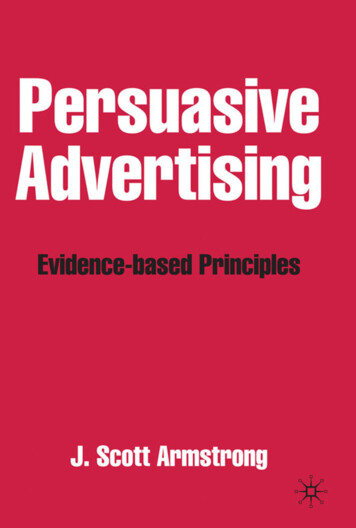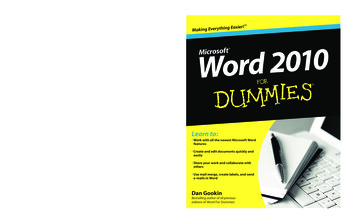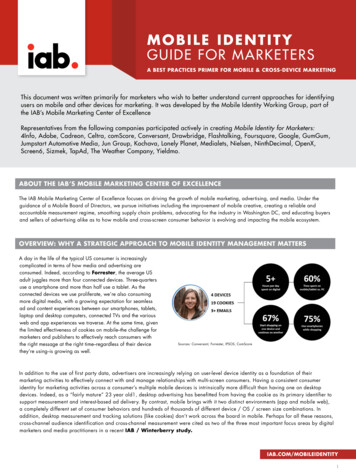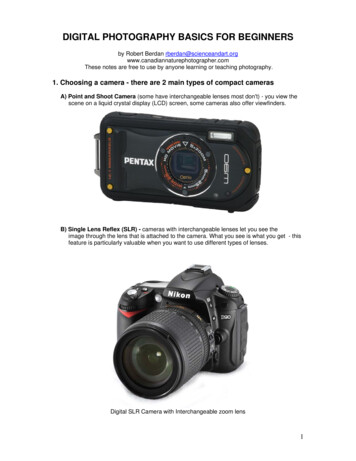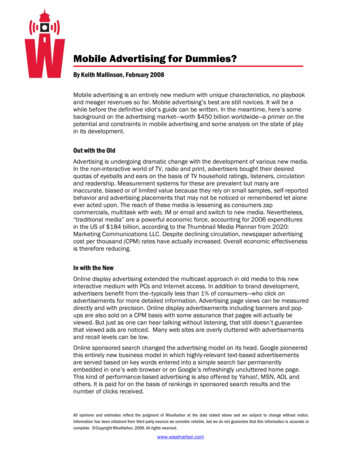
Transcription
Mobile Advertising for Dummies?By Keith Mallinson, February 2008Mobile advertising is an entirely new medium with unique characteristics, no playbookand meager revenues so far. Mobile advertising’s best are still novices. It will be awhile before the definitive idiot’s guide can be written. In the meantime, here’s somebackground on the advertising market—worth 450 billion worldwide—a primer on thepotential and constraints in mobile advertising and some analysis on the state of playin its development.Out with the OldAdvertising is undergoing dramatic change with the development of various new media.In the non-interactive world of TV, radio and print, advertisers bought their desiredquotas of eyeballs and ears on the basis of TV household ratings, listeners, circulationand readership. Measurement systems for these are prevalent but many areinaccurate, biased or of limited value because they rely on small samples, self-reportedbehavior and advertising placements that may not be noticed or remembered let aloneever acted upon. The reach of these media is lessening as consumers zapcommercials, multitask with web, IM or email and switch to new media. Nevertheless,“traditional media” are a powerful economic force, accounting for 2006 expendituresin the US of 184 billion, according to the Thumbnail Media Planner from 2020:Marketing Communications LLC. Despite declining circulation, newspaper advertisingcost per thousand (CPM) rates have actually increased. Overall economic effectivenessis therefore reducing.In with the NewOnline display advertising extended the multicast approach in old media to this newinteractive medium with PCs and Internet access. In addition to brand development,advertisers benefit from the--typically less than 1% of consumers—who click onadvertisements for more detailed information. Advertising page views can be measureddirectly and with precision. Online display advertisements including banners and popups are also sold on a CPM basis with some assurance that pages will actually beviewed. But just as one can hear talking without listening, that still doesn’t guaranteethat viewed ads are noticed. Many web sites are overly cluttered with advertisementsand recall levels can be low.Online sponsored search changed the advertising model on its head. Google pioneeredthis entirely new business model in which highly-relevant text-based advertisementsare served based on key words entered into a simple search bar permanentlyembedded in one’s web browser or on Google’s refreshingly uncluttered home page.This kind of performance-based advertising is also offered by Yahoo!, MSN, AOL andothers. It is paid for on the basis of rankings in sponsored search results and thenumber of clicks received.All opinions and estimates reflect the judgment of WiseHarbor at the date stated above and are subject to change without notice.Information has been obtained from third-party sources we consider reliable, but we do not guarantee that this information is accurate orcomplete. Copyright WiseHarbor, 2008. All rights reserved.www.wiseharbor.com
Mobile Advertising for Dummies?2Whereas US online advertising is growing from 14 billion 2006 to 20 billion in 2007,mobile advertising is still so new, with relatively small numbers of insertions, that it isimpossible to measure the trade with precision. Most published industry analystforecasts are for in excess of 10 billion in global mobile advertising revenues by2011, but estimates for 2007 are typically nonexistent or modest. According to aSeptember 2007 report from The Kelsey Group, for example, US mobile searchadvertising revenues will rise from just 33.2 million in 2007 to 1.4 billion in 2012.Market leader AdMob claims 2.4 billion worldwide ad insertions in January 2008, butthere is still a lot of unsold inventory with only a small proportion of mobile web pagescarrying any advertising. Exhibit 1 illustrates some exceptions in the US.Exhibit 1Mobile Ads are Served to a Minority of Pages Viewed Today: Some ExceptionsMobile Advertising is Embryonic and UniqueMobile is a medium with a variety of delivery modes for electronic content includingring tones, wallpapers, video and associated advertising. So far, a significant proportionof mobile advertising is in text messaging with multimedia messaging set to follow.Video clips can be preceded by video advertisements. The emerging Mobile TV marketprovides opportunities for ad insertion “breaks” in a similar way to traditional TV.Greatest expectations by most interested parties including carriers, devicemanufacturers and advertisers are with mobile emulating online with graphicalbanners, text taglines and mobile search. Eventually, some of these different types ofmobile advertising will become blended with online in their sale and delivery.But the mobile medium is distinctly different to online. Mobile’s unique assets willenable it to exceed the performance of other media in many ways, although it also hasits limitations, as indicated in Exhibit 2. Some factors are transient. For example,www.wiseharbor.com
Mobile Advertising for Dummies?3increased openness to third party content and access to subscriber profiles frommobile carriers, the adoption of ad format display standards, identification andrecognition of best practices, availability of measurement systems and pricingbenchmarks will help develop the market. An increase in clutter, spam and viruses willimpede it.Exhibit 2Benefits and Challenges of Advertising on Mobile versus Online and Traditional MediaBenefitsChallengesReach: Whereas mobile phone penetration isapproaching 85% of US population, theInternet only reaches 70% of homes andworkplaces.Accessibility: Small screens and limitedkeyboards constrain display and interactivecapabilities. Innovations such as voicerecognition will help.Pervasive: Always with you, always on.Nascent: Embryonic and unproven market withno success story case studies to follow.Personal: Driven by individuals’demographics, behavioral history andpresence, including automatic locationidentification.Heterogeneous: Technical challenges withdiffering screen sizes and software, otherstandards for mobile web and rich clients.Trade bodies including MMA and MAG1 aresetting advertising display standards.Intrusiveness: Targeted inventory on thisintimate device is an advertiser’s dream.Intrusiveness: Potentially a consumer’snightmare if conditions for push advertisingopt-in are lax and with other possible abuses.Measurement: As with online, it should bepossible to measure the impact of campaignsdirectly.Gatekeepers: Carriers might block or impedesome third party innovators.New medium: Novelty factor with limitedclutter, spam and malware problems.New medium: Limited quality control andmeasurement systems. More rules of the road(e.g., ad display frequency caps), best practicesand pricing benchmarks are needed.Fraud resistance: Carriers can audit usageand click-to-call can easily be verified.Infrastructure: Immature systems formanaging campaigns, inventory, frequencycapping on ad views and revenue yields onmultiple formats including display, search,SMS, MMS and video.Business models: Mobile advertising providesan opportunity to disrupt the established valuechain with potentially large rewards for somenewcomers.Business models: It is not yet clear how therevenues will be divided and whether there willbe sufficient reward for all essential players inthe value chain.1Mobile Marketing Association (MMA) and dotMobi Advisory Group (MAG)www.wiseharbor.com
Mobile Advertising for Dummies?4A New and Expanding EcosystemAdvertising revenues are no more carrier birthrights in mobile than they were onlinewhere the web entirely bypassed US carriers and many others worldwide. Carriercontrol of the mobile ecosystem with gate-keeping mobile content access, walledgardens and revenue sharing (from content and advertising providers) has limitedrather than generated growth on the mobile Internet. Carriers should contentthemselves that advertising can stimulate network demand that will generateincremental usage charges and justify additional data service subscription charges. Alot of mobile content is going off-portal and advertising is shadowing this trend. Thishelps carriers because it expands the market overall.Innovative players in mobile advertising will propel this new market by both allying withand competing against carrier initiatives. Media buyers for premier national (or global)brands such as Coke insist on high levels of subscriber reach that cannot be providedby any single carrier, while also seeking the simplicity of purchasing a full nationalcampaign from a single source. AdMob has moved very aggressively into US branddisplay advertising to satisfy this kind of demand with on- and off-deck access to adspace inventory on 3,500 sites including ESPN and CBS.What’s it Worth?Mobile advertising prices are higher than average online prices for banners and popups. However, online prices vary enormously depending on the web site: primeinventory such as the Wall Street Journal fetches a CPM of 70 or more. Rates varysignificantly depending on target and other factors with prices to advertisers typically inthe 12- 20 range for the mobile Internet in the US. Prices as much as 50% higher areobserved in some European nations including the UK and Spain. Mobile prices aretoward the bottom end of the CPM ranges in print magazines and are similar toaverage rates for US—inattentive or otherwise-- TV “viewers”. These cross-media pricecomparisons are made in recognition of the fact that what one is buying is verydifferent in each case with price levels in any medium subject to a variety of mediumspecific factors.Performance-based advertising with keyword searching is growing to dominate onlineand this approach will likely also be a major category in mobile. Medio, JumpTap andMicrosoft (formerly MotionBridge) are providing “white label” search capabilities andassociated advertising on wireless carrier portals in competition to on-portal or offportal competition from Google, Yahoo! and others. Rates averaging around 20 centsper click are on the low side versus online keyword prices that are skewed to averagein excess of one dollar with some very expensive keywords driving high ticket-pricedpurchases such as insurance and financial services. Click-to-call shows great potential,in part because it has no analogy with other media. Only a small minority of computerscan make calls, whereas by definition all mobile phones can. On the basis that theaverage yellow pages book look-up costs advertisers one dollar, as claimed by one USyellow pages publisher CEO, an average click-to-call for a taxi, pizza or restaurantreservation should be worth as much. In fact, 7-10 per call is a representative pricerange achieved for higher ticket-priced items including services such as plumber housecalls.www.wiseharbor.com
Mobile Advertising for Dummies?5How’s it Sold?Mobile advertising distribution is still at a formative stage with a variety of channelstrategies vying for leadership. Most advertising space (called inventory), including thaton the mobile portal of The Weather Channel is sold directly by in-house sales forces.AdMob’s value proposition is with its broader reach. Major online players such asGoogle seek to capitalize on their existing sales channel and customer buying withbundled offerings. Nokia’s Enpocket acquisition is an outsourced advertising saleschannel that appeals to advertisers with its campaign management support tools. CBSworks entirely through third party networks including AOL, AdMob and Millennial.Has Mobile Advertising’s Time Come Yet?It is just a matter time before the mobile Internet and all that comes with it includingmobile advertising takes off in a big way, but don’t hold your breath waiting. There arechallenges with development of the mobile Internet in general; upon which mobileadvertising’s biggest opportunity depends. For example, data connectivity prices arestill too high to encourage significant use by more than a small minority. Lack ofindependently audited measurements and difficulties in reaching targets across allcarriers continue to impede mobile advertising and make it difficult to justify declaringthat 2008 is year that mobile advertising will finally take off.Nobody knows when everything will come together sufficiently well for explosive growth.That could be at any time. However, now is certainly a good time to get in position tocapitalize on the upcoming opportunity.About WiseHarborWiseHarbor solves business problems in wireless and mobile communications.WiseHarbor is a global research and consulting company with expertise in: Technology supply for networks and devices Carrier services for developed and developing nations End user markets with enterprises and consumers Related services including mobile media, advertising, local search, billingand paymentsWiseHarbor has a broad set of business analysis skills with significant experience in: Competitive analysis Market research Regulation and licensing Business modeling and valuationsWiseharbor’s founder Keith Mallinson has more than 20 years experience in thetelecommunications industry, as research analyst, business consultant and as atestifying expert witness. He has published numerous reports and speaks publicly on awide variety of mobile industry topics. He is a columnist with Wireless Week magazine.www.wiseharbor.com
Mobile Advertising for Dummies? 4 A New and Expanding Ecosystem Advertising revenues are no more carrier birthrights in mobile than they were online where the web entirely bypassed US carriers and many others worldwide. Carrier control of the mobile

